Update: Falcon babies identified, tagged
Updated: Monday, May 19
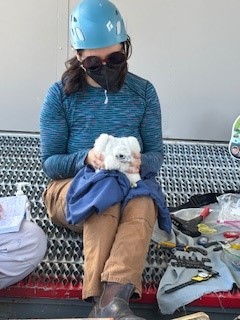
If you looked at the live camera in the peregrine falcon nest in the 10 a.m. hour of Monday, May 19, you might’ve panicked at the sight of…no hatchlings! Or depending on the time, you might’ve been thoroughly surprised to see a human taking said hatchlings! Regardless, all four babies are perfectly fine. In fact, they’ve been identified and banded for future tracking.
UC Davis Health, congratulations, you have three beautiful baby girls and one handsome baby boy.
Zeka Glucs is the director of the Predatory Bird Research Group. Glucs and three graduate students from Davis and UC Davis Health’s William Corbett gave the babies an exam and collected feather samples, in addition to the banding.
"Peregrine falcon feather samples are valuable tools for studying the bird's health, especially regarding mercury contamination,” Corbett said. “Researchers have collected feather samples from various peregrine falcon populations to analyze mercury levels. These analyses can provide insights into the birds' exposure to pollutants and how these contaminants impact their health and reproductive success.”
Corbett reported that the birds are “very healthy” and will now be left alone.

The next milestone takes place when the babies should start flying in three to four weeks.
“That is when we would like our staff to be on the lookout should any birds get stranded on the ground,” Corbett said.
When that time comes, if you see a bird on the ground, it’s best to call the non-emergency UC Davis Health Police Department line at 530-752-1727, and they will contact William Corbett.
(Note: Some have asked about the team not wearing gloves, worried the mother falcon will shun the babies. The team assured us gloves were not necessary and nothing will change between parents and babies.)
<<Original Story>>
The four peregrine falcon chicks are eating well and continue to grow after hatching. Check out the family photos they recently took here:
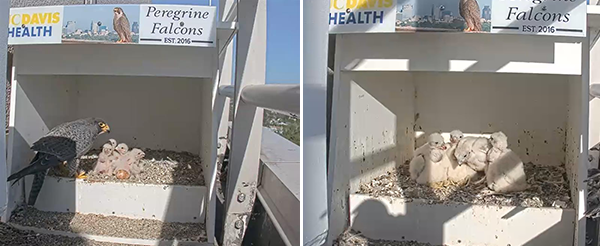
The four baby falcons were born at the beginning of May and spent most of their time resting in the sunshine in the nest. The fifth egg was unviable.
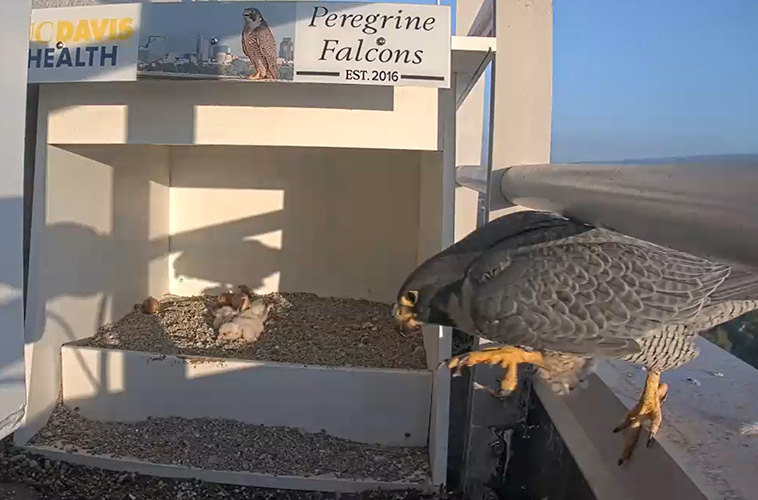
Typically, the peregrine falcon eggs hatch around 34 days after being laid. The mother bird laid her first egg on March 17, so, 34 days later would have been April 20. The final egg was laid around March 28, so 34 days later would be May 1.
Did you know? Peregrine falcon hatchlings are called “eyases.” Once the incubation period ends, and the eggs hatch, the nestling period begins. This portion will last between 35-42 days. The eyases hatched with their eyes closed which is normal. Their typical weight at birth is about 1.5 ounces.
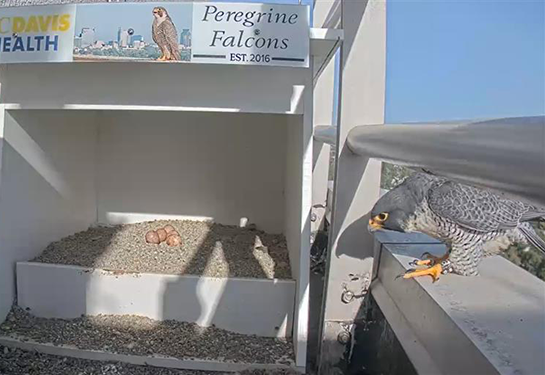
The falcon began laying her eggs the week of March 17. Viewers discovered the first egg around 8 a.m. March 18 (though she might have laid the egg at some point overnight). Initially, we believed the second egg was laid on Friday, March 21. In-house falcon expert Bill Corbett said the time between eggs is "usually every 48 hours" so the extended time between the first and second would be considered unusual. However, a UC Davis Health employee emailed that she just happened to catch the falcon laying the second egg.
"I'm fairly certain I watched the falcon lay the second egg on Thursday, March 20 at 3:12 p.m.," the staff member said. "She puffed up all big, chirped and moved, and I noticed two eggs at that time."
Cameras picked up the third egg on Monday, March 24, though that egg could have been laid over the weekend as well.
A viewer then emailed about the fourth egg, as well.
"I was almost certain I saw the fourth egg being laid this morning (March 25) when I went to take a gander," the viewer wrote in. "She was moving around in a way I hadn’t seen before then, pop! There it was. After she laid the egg and settled back in then started nesting by moving the gravel around with her beak in the same area that the paint is worn down it the front. (It was) so cool to see!"
Currently, there are five eggs.
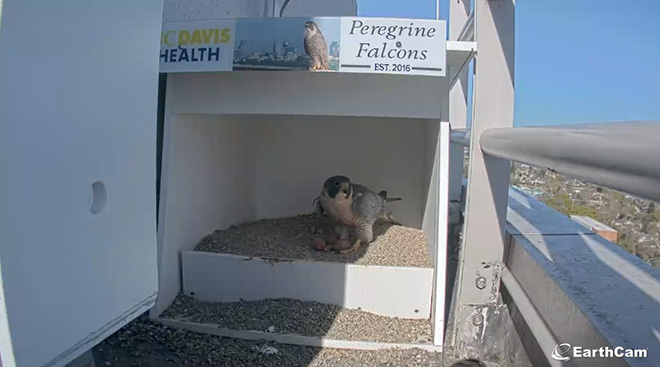
Corbett said three to four eggs a season is "normal." But while a fifth egg is rare, it's not the first time for this falcon.
Last year, the falcon mother laid four eggs. Unfortunately, none were thought to be viable, and our experts believe she removed them from the nest herself.
Every March, almost as regularly as swallows return to Capistrano, UC Davis Health team members begin watching the cameras atop UC Davis Medical Center. They’re hoping to spot our longtime peregrine falcon friends.
On February 27, the first tip came in: The bird was back.
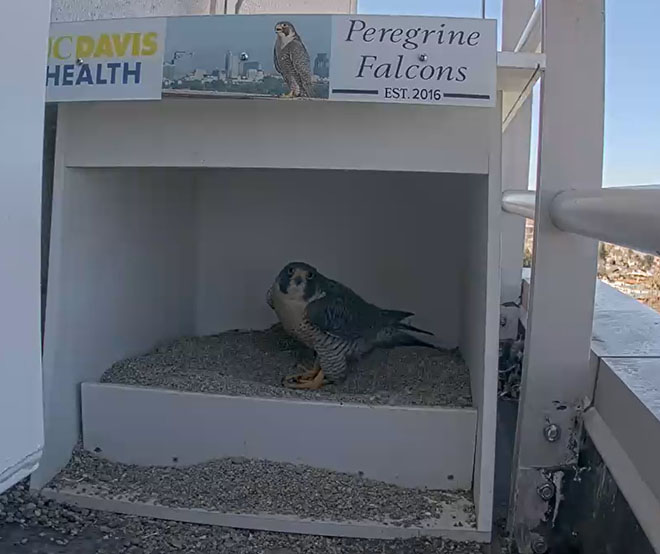
We’ve since taken to the skies — well, the cameras in the skies — to see if we could spot when our peregrine first arrived. Timelapse footage shows one of the birds appeared as early as mid-January to scout out the nest.
<<Watch the UC Davis Health peregrine falcon camera here>>
The visits were sporadic until recently. Now, at least one of the falcons has been a regular at the nest, creating a shallow pit for future eggs — hopefully.
The birds have nested on the medical center roof since at least 2015. Each year, the female lays the eggs in March. They typically hatch around 34 days later.
For now, we’ve officially moved into the egg watch phase.
About peregrine falcons
Peregrine falcons are one of the world's fastest birds. When power-diving from great heights to strike their prey, the falcons can reach speeds of 200 mph. The birds were on the federal list of endangered species at one time. They were among the first birds on California's Endangered Species List. A ban on the insecticide DDT in 1972 helped the species recover enough so that the raptor could be removed from the federal list in 1999. Ten years later, peregrine falcons were removed from the state’s list.
Last year’s falcons
In 2024, the falcon initially laid four eggs. But over the course of a few weeks in April, one by one, the eggs disappeared.
We contacted Michelle Hawkins, the director of the California Raptor Center at UC Davis, to find out more. Hawkins went through our video footage. The belief was that the eggs simply cracked, and the mother bird removed them. Previous years have been more successful.
In 2023, the falcon successfully hatched four eggs. The year prior saw similar triumph.



